How Did Mary Jackson Change The World
| Mary Jackson | |
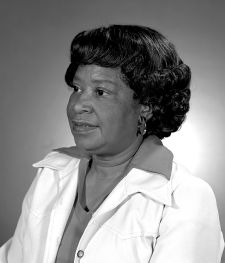 Mary Jackson in 1979 | |
| Built-in | Mary Winston April 09 1921(1921-04-09) Hampton, Virginia, US |
|---|---|
| Died | February 11 2005 (anile 83) Hampton, Virginia, US |
| Fields | Aerospace technology, mathematician |
| Institutions | NASA |
| Alma mater | Hampton Plant |
| Spouse | Levi Jackson, Sr. (m. 1944) |
Mary Jackson (née Winston, April nine, 1921 – Feb eleven, 2005) was an American mathematician and aerospace engineer at the National Advisory Committee for Aeronautics (NACA), which in 1958 was succeeded by the National Helmsmanship and Space Assistants (NASA). She worked at Langley Research Center in Hampton, Virginia, for near of her career, starting as a "human reckoner" at the segregated West Area Computing partitioning in 1951. She took advanced engineering classes and became NASA's first black female engineer.
After 34 years as a NASA engineer, she go manager of both the Federal Women's Program Manager in the Office of Equal Opportunity Programs and the Affirmative Action Program Manager. In this role, she worked to influence the hiring and promotion of women in NASA's science, engineering, and mathematics careers.
Jackson is one of the iii protagonists in Hidden Figures, the film adaptation of Margot Lee Shetterly's history of the influential African-American women mathematicians and engineers at NASA in the mid-twentieth century. Her legacy lies non just in her work every bit an aerospace engineer, but in breaking barriers of race and gender in her field, and in encouraging minority young people to fulfill their potential, particularly in the Stem fields.
Life
Mary Eliza Winston was built-in on April 9, 1921, to Ella Winston (née Scott) and Frank Winston.[1] She grew up in Hampton, Virginia, where in 1937 she graduated from the all-black George P. Phenix Training School with highest honors.[2]
Mary earned dual available's degrees in mathematics and physical science from Hampton University in 1942.[3] [four] She was a fellow member of the Alpha Kappa Blastoff.[3]
After graduation, she taught mathematics for a year at an African-American school in Calvert County, Maryland.[2] At that time, public schools were nonetheless segregated across the South. She also began tutoring loftier school and higher students, which she continued to do throughout her life.[5]
By 1943, she had returned to Hampton, where she became a bookkeeper at the National Catholic Customs Center at that place. On November 18, 1944 Mary was married to Levi Jackson, Sr., a crewman in the U.S. Navy.[four] [6] She continued working as a receptionist and clerk at the Hampton Institute's Health Department until she became pregnant and eventually returned home for the birth of her son, Levi Jackson, Jr. They later had a daughter, Carolyn Marie Lewis.[4]
Jackson served for more thirty years every bit a Girl Scout leader.[2] She was noted in the 1970s for helping African American children in her community create a miniature air current tunnel for testing airplanes.[4] [7]
Mary Jackson died peacefully on February 11, 2005, historic period 83.[3]
Career
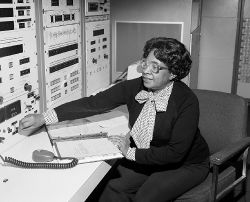
Jackson working at a control panel
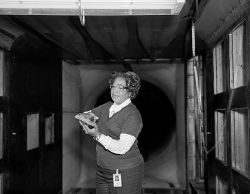
In 1951, Jackson became a clerk at the Office of the Chief Army Field Forces at Fort Monroe.[v] From in that location she was recruited past the National Informational Commission for Aeronautics (NACA), which in 1958 was succeeded by the National Helmsmanship and Infinite Administration (NASA).[4] [vii] She started every bit a enquiry mathematician, or "human calculator," at the Langley Research Center in her hometown of Hampton, Virginia. She worked nether Dorothy Vaughan in the segregated Due west Expanse Computing Section.[2]
In 1953, she accepted an offering to work for engineer Kazimierz Czarnecki in the Supersonic Pressure Tunnel. This four anxiety (1.2 m) by 4 anxiety (1.2 thousand), 60,000 horsepower (45,000 kW) air current tunnel was used to written report forces on a model by generating winds at almost twice the speed of sound.[2] Czarnecki encouraged Jackson to undergo training so that she could exist promoted to an engineer. To authorize for the task, she needed to take graduate-level courses in mathematics and physics which were offered in a night program past the Academy of Virginia, held at the all-white Hampton High Schoolhouse. Jackson successfully petitioned the City of Hampton to permit her to attend the classes. Afterward completing the courses, she was promoted to aerospace engineer in 1958, and became NASA'due south offset black female engineer.[vii] She analyzed data from wind tunnel experiments and real-world shipping flight experiments at the Theoretical Aerodynamics Branch of the Subsonic-Transonic Aerodynamics Division at Langley. Her goal was to empathise air menstruum, including thrust and drag forces, in social club to ameliorate United States planes.[4]
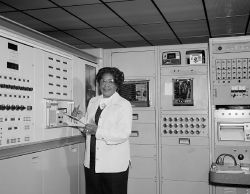
Jackson working at the Langley Enquiry Eye
Jackson worked as an engineer in several NASA divisions: the Compressibility Research Sectionalisation, Full-Calibration Research Division, Loftier-Speed Aerodynamics Division, and the Subsonic-Transonic Aerodynamics Division.[5] She ultimately authored or co-authored 12 technical papers for NACA and NASA.[5] During this time she helped women and other minorities to accelerate their careers, including advising them how to study in club to qualify for promotions.[8]
By 1979, Jackson had achieved the most senior title within the engineering section. She decided to accept a demotion in order to serve as an administrator in the Equal Opportunity Specialist field. After undergoing training at NASA Headquarters, she returned to Langley where she worked to make changes and highlight women and other minorities who were achieved in the field. She served as both the Federal Women's Program Manager in the Office of Equal Opportunity Programs and as the Affirmative Activeness Program Manager, influencing the career paths of women in science, engineering, and mathematics positions at NASA.[2] [viii] She continued to work at NASA until her retirement in 1985.
Legacy
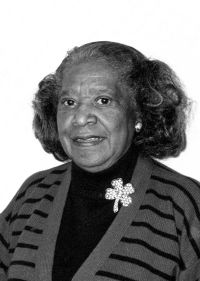
Mary Jackson, NASA Homo Computer
The 2016 film Hidden Figures recounts the NASA careers of Jackson, Katherine Johnson, and Dorothy Vaughan, specifically their work on Project Mercury during the Space Race. The film is based on the volume of the aforementioned name by Margot Lee Shetterly, a history of the African-American women who contributed so significantly to the work of NASA. Jackson is portrayed in the motion picture by Janelle Monáe.[nine]
Jackson was outstanding not only in the field of aerospace engineering science, only she was defended to helping others and improving their lives, specially those of African-American women. Her spirit and character were well represented past a Langley enquiry profiler as "gentle lady, wife and mother, humanitarian and scientist."[2] For Mary Jackson, science and service went manus in hand. In the 1970s, she helped young people in the science club at her local community center to build their own air current tunnel and utilize it to comport experiments:
"Nosotros take to exercise something like this to get them interested in scientific discipline," she said in an article for the local paper. "Sometimes they are not aware of the number of blackness scientists, and don't fifty-fifty know of the career opportunities until it is as well belatedly."[2]
In 2018, the Salt Lake City School Board voted that Jackson Unproblematic School in Common salt Lake City would from and so on be officially named subsequently Mary Jackson rather than (every bit it used to be) subsequently President Andrew Jackson.[x]
In 2019, Jackson was posthumously awarded the Congressional Gold Medal, along with others featured in Hidden Figures.[eleven]
On June 24, 2020, NASA Administrator Jim Bridenstine announced that the agency's headquarters building in Washington, D.C. would be named after Mary W. Jackson and referred to every bit the Mary Westward. Jackson NASA Headquarters.[12]
Awards and honors
- Apollo Group Achievement Honor, 1969[two] [5]
- Daniels Alumni Award for Outstanding Service to Disadvantaged Youth[5]
- National Quango of Negro Women, Inc. Document of Recognition for Outstanding Service to the Community[5]
- Distinguished Service Award for her work with the Combined Federal Entrada representing Humanitarian Agencies, 1972[5]
- Langley Research Heart Outstanding Volunteer Award, 1975[five]
- Langley Research Center Volunteer of the Twelvemonth, 1976[2]
- Iota Lambda Sorority Award for the Peninsula Outstanding Woman Scientist, 1976[v]
- King Street Customs Center Outstanding Award[v]
- National Technical Association'south Tribute Award, 1976[5]
- Hampton Roads Chapter "Book of Golden Deeds" for service[5]
- Langley Inquiry Center Document of Appreciation, 1976–1977[5]
- Congressional Gold Medal[11]
Publications
- Czarnecki, G.R., and Mary W. Jackson. Effects of Nose Angle and Mach Number on Transition on Cones at Supersonic Speeds (NACA TN 4388) National Informational Committee for Aeronautics, September 1958. Retrieved July 3, 2020.
- Jackson, Mary W., and K.R. Czarnecki. Investigation by Schlieren Technique of Methods of Fixing Fully Turbulent Flow on Models at Supersonic Speeds National Helmsmanship and Space Administration, April 1960. Retrieved July three, 2020.
- Czarnecki, K.R., and Mary Westward. Jackson. Effects of Cone Angle, Mach Number, and Nose Blunting on Transition at Supersonic Speeds (NASA TN D-634) NASA Langley Research Center, January 1961. Retrieved July 3, 2020.
- Jackson, Mary Due west., and K.R. Czarnecki. Purlieus-Layer Transition on a Grouping of Blunt Olfactory organ Shapes at a Mach Number of 2.20 (NASA TN D-932) NASA Langley Research Center, July 1961. Retrieved July 3, 2020.
- Czarnecki, 1000.R., Mary W. Jackson, and William J. Monta. Studies of Pare Friction at Supersonic Speeds (Turbulent Boundary Layer and Skin Friction Data for Supersonic Transports) 1963.
- Jackson, Mary W, K.R. Czarnecki, and William J. Monta. Turbulent Pare Friction at High Reynolds Numbers and Depression Supersonic Velocities National Aeronautics and Space Administration, July 1965. Retrieved July three, 2020.
- Czarnecki, K.R., Mary W. Jackson, and R.B. Sorrells. Measurement by wake momentum surveys at Mach i.61 and 2.01 of turbulent boundary-layer skin friction on five swept wings National Aeronautics and Space Assistants, December 1, 1966. Retrieved July 3, 2020.
- Czarnecki, K.R., Mary W. Jackson, and J.M. Allen. Boundary-layer transition on hypersonic-cruise aircraft National Aeronautics and Space Administration, January i, 1967. Retrieved July three, 2020.
- Czarnecki, Yard.R., and Mary Westward. Jackson. Theoretical pressure distributions over arbitrarily shaped periodic waves in subsonic compressible flow and comparison with experiment National Aeronautics and Space Assistants, November 1, 1970. Retrieved July 3, 2020.
- Czarnecki, K.R., and Mary W. Jackson. Turbulent Boundary-Layer Separation due to a Forward-Facing Step AIAA Journal xiii(12) (December 1973): 1585–1591. Retrieved July 3, 2020.
Notes
- ↑ Mary Winston-Jackson Biography.com, June 25, 2020. Retrieved July three, 2020.
- ↑ ii.0 2.1 2.ii 2.iii 2.iv 2.5 ii.six two.7 2.8 two.9 Margot Lee Shetterly, Mary Jackson Biography NASA. Retrieved July iii, 2020.
- ↑ 3.0 3.1 three.2 Mary Winston Jackson Daily Press, Feb thirteen, 2005. Retrieved July 3, 2020.
- ↑ four.0 4.i 4.2 4.3 4.iv iv.5 Wini Warren, Black Women Scientists in the United States (Indiana University Press, 2000, ISBN 978-0253336033).
- ↑ 5.00 5.01 5.02 5.03 5.04 5.05 5.06 5.07 5.08 5.09 5.10 v.11 five.12 5.13 Mary W. Jackson, Federal Women's Program Coordinator NASA, October 1979. Retrieved July iii, 2020.
- ↑ Certificate of Marriage November twenty, 1944. Retrieved July 3, 2020.
- ↑ 7.0 7.one 7.2 Shawn D. Lewis, The Professional Adult female: Her Fields Have Widened Ebony 32(10) (August 1977). Retrieved July 3, 2020.
- ↑ 8.0 8.i Gloria Champine, Mary Jackson NASA. Retrieved July 3, 2020.
- ↑ Cara Buckley, Uncovering a Tale of Rocket Science, Race and the '60s The New York Times, May 20, 2016. Retrieved July iii, 2020.
- ↑ Scott Simon, A Schoolhouse Goes From Andrew Jackson To Mary Jackson NPR, Feb 10, 2018. Retrieved July iii, 2020.
- ↑ 11.0 eleven.1 H.R.1396 - Hidden Figures Congressional Gilded Medal Human action Congress.gov, November 8, 2019. Retrieved July 3, 2020.
- ↑ Sean Potter, NASA Names Headquarters After 'Hidden Figure' Mary Westward. Jackson NASA, June 26, 2020. Retrieved July three, 2020.
References
ISBN links support NWE through referral fees
- Golemba, Beverly. Human Computers: The Women in Aeronautical Research, unpublished manuscript 1994, NASA Langley Athenaeum. Retrieved July 3, 2020.
- Narins, Brigham. Notable Scientists: From 1900 to the Present. Gale Group, 2001. ISBN 9780787617547
- Shetterly, Margot Lee. Hidden Figures: The American Dream and the Untold Story of the Blackness Women Mathematicians Who Helped Win the Space Race. William Morrow Paperbacks, 2016. ISBN 978-0062363602
- Warren, Wini. Black Women Scientists in the United States. Indiana University Press, 2000. ISBN 978-0253336033
- Zierdt-Warshaw, Linda, Alan Winkler, and Leonard Bernstein. American Women in Technology: An Encyclopedia. ABC-CLIO, 2000. ISBN 978-1576070727
External links
All links retrieved July iii, 2020.
- The Human Estimator Projection
- Human being Computers at NASA
- Mary Winston Jackson at Find A Grave
Credits
New World Encyclopedia writers and editors rewrote and completed the Wikipedia commodity in accordance with New World Encyclopedia standards. This article abides by terms of the Creative Eatables CC-by-sa 3.0 License (CC-by-sa), which may be used and disseminated with proper attribution. Credit is due under the terms of this license that tin can reference both the New World Encyclopedia contributors and the selfless volunteer contributors of the Wikimedia Foundation. To cite this article click here for a list of acceptable citing formats.The history of before contributions past wikipedians is accessible to researchers here:
- Mary_Jackson_(engineer) history
The history of this commodity since it was imported to New Globe Encyclopedia:
- History of "Mary Jackson (engineer)"
Notation: Some restrictions may apply to utilise of individual images which are separately licensed.
Source: https://www.newworldencyclopedia.org/entry/Mary_Jackson_(engineer)
Posted by: barnesweng1974.blogspot.com

0 Response to "How Did Mary Jackson Change The World"
Post a Comment